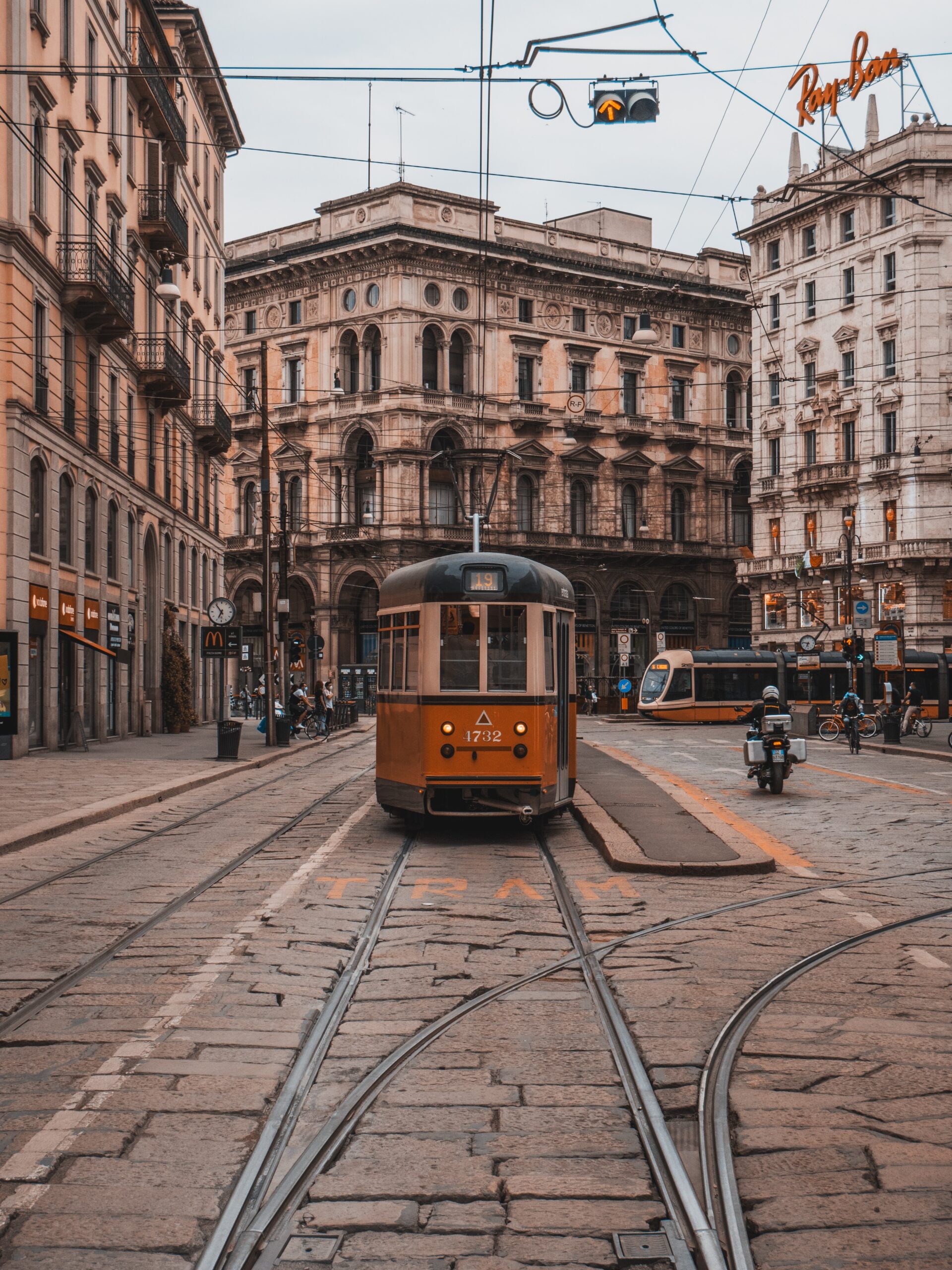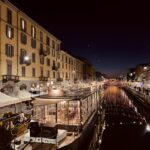Milan is a huge city, famous for fashion, culture and nightlife. This city is divided into many areas, very different from each other and, for each of them, we want to focus on some places that, according to us at FollowMi Around, are worth visiting to make your trip to Milan more authentic and characteristic.
Today we will start from the historic center and tell you some curiosities related to the most famous and well-known places in Milan, without forgetting the hidden gems that this magnificent city reserves.
Duomo Cathedral
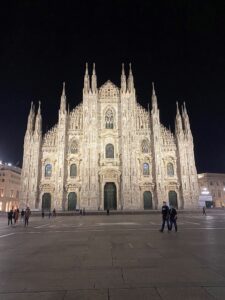 The Duomo of Milan is is the fifth largest church in the world and is also the building that houses the highest number of statues in the world: as many as 3,400.
The Duomo of Milan is is the fifth largest church in the world and is also the building that houses the highest number of statues in the world: as many as 3,400.
It was originally a place of worship dedicated to Belisama, a female deity of Celtic origin; the construction of the Duomo lasted nearly half a millennium. Construction officially began in 1386, at the behest of Archbishop Antonio da Saluzzo and with the endorsement of the lord of Milan, Gian Galeazzo Visconti. It was Napoleon who restarted work on the neo-Gothic facade in 1805, the year he was crowned King of Italy right inside the Duomo.
The Duomo is to this day an ongoing construction site. The Veneranda Fabbrica del Duomo di Milano has been involved in the enhancement and conservation of the Cathedral since 1387: marble work, for example, has continued uninterrupted since the 14th century.
Teatro alla Scala
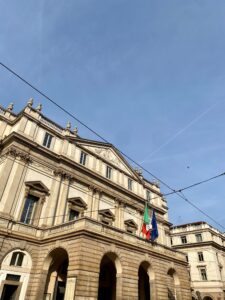
In 1381, exactly where Milan’s most famous theater stands today, stood the church of Santa Maria alla Scala, which had been built by Beatrice Regina della Scala. Then, after 400 years, the church was torn down by order of Maria Theresa of Austria to make way for the famous theater. On August 3, 1778, it was inaugurated with the first opera by Antonio Salieri.
Today the Premiere at the theater is traditionally held on December 7, because on this day is celebrated St. Ambrose, the patron saint of the city of Milan.
When entering La Scala Theater, you cannot fail to notice the huge chandelier in the center of the stalls, consisting of as many as 400 bulbs. To given a true sense of the size of the chandelier, let us only tell you that inside the bowl of the chandelier itself can fit a man.
Another interesting curiosity is that at La Scala there is a box, number 13, which is very different from all the others. It is not known exactly which family owned it, however this is the only box in the entire theater that is filled with mirrors, which apparently allow you to see every point of the theater.
Galleria Vittorio Emanuele
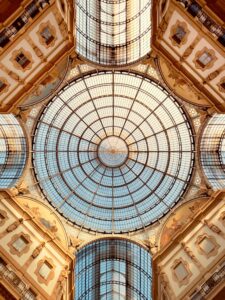 Also called the ” Salotto of Milano”, inside the Galleria in fact the bourgeois life of Milan was concentrated, including elegant boutiques, restaurants and cafes.
Also called the ” Salotto of Milano”, inside the Galleria in fact the bourgeois life of Milan was concentrated, including elegant boutiques, restaurants and cafes.
It was designed by architect Mengoni: on March 7, 1865, King Vittorio Emanuele II himself placed the foundation stone of the great work dedicated to him, and the work was completed in only 3 years.
The space located at the intersection of the main arm, which connects Piazza Duomo and Piazza della Scala, is called the “central octagon.” Its shape was obtained by cutting the four corners at the intersection of the galleries, and at the top of the walls are the four lunettes representing the four Continents: Europe, America, Asia and Africa. On the floor, a bull is depicted: for years the animal has been attracting Milanese and visitors from all over the world to perform the superstitious ritual: three turns on the bull’s balls with the heel of the right foot. Rumors over the years have been various about this rite, from fertility for women to securing a second visit to Milan to good luck for the new year.
Piazza Mercanti
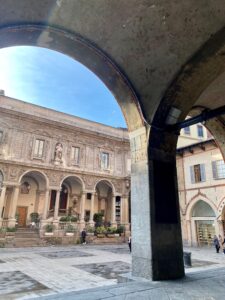 Rising in the 13th century, Merchants’ Square was the medieval city hub of economic exchanges and meetings of the various merchants. Originally larger, almost twice as large as it is today, it also included the collegio dei Giureconsulti
Rising in the 13th century, Merchants’ Square was the medieval city hub of economic exchanges and meetings of the various merchants. Originally larger, almost twice as large as it is today, it also included the collegio dei Giureconsulti
In the 19th century two gates were demolished and the area became what it still is today: a passageway between Piazza Duomo and Piazza Cordusio.
A square that is not very visible today, but nevertheless has always been a protagonist of great events and stories: Merchants’ Square is one of the oldest places in Milan, even before the building of Milan Cathedral.
It is said, in fact, that in those days merchants would stand next to two columns placed obliquely with holes in them to talk to each other and exchange information of the trade. What is still known today as the echo of the loggia is a phenomenon that attracts many tourists.
Università Statale
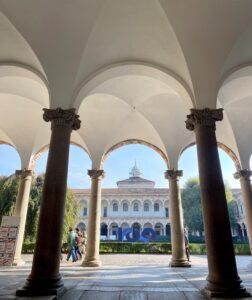 Founded in 1923, the university holds within it several curiosities and peculiarities.
Founded in 1923, the university holds within it several curiosities and peculiarities.
Università Studi Milano has a fascinating history that is intertwined with that of Ca’ Granda, the Renaissance-era building in which it is housed today. This imposing palace was commissioned by Francesco Sforza and built starting in 1456, but was completed in the early 1800s.
The beauty of the four cloisters facing it-the Cortile Ghiacciaia, the Cortile Farmacia, the Cortile Legnaia and the Cortile Bagni.
Among its treasures is the Church of the Blessed Virgin Annunciata, an ancient hospital chapel whose origins date back to the 1500s. This sacred place holds a secret that few know: in the basement is a crypt that houses the remains of patients who died between 1637 and 1695.
San Bernardino alle Ossa
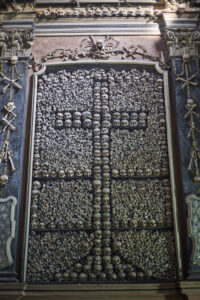 Also known as San Bernardino ai Morti, the Church of San Bernardino alle Ossa in Milan is a religious building dating back to the 13th century. It has the same origin as the Ossuary and that of the Brolo Hospital, a structure that no longer exists today and was once intended to care for lepers.
Also known as San Bernardino ai Morti, the Church of San Bernardino alle Ossa in Milan is a religious building dating back to the 13th century. It has the same origin as the Ossuary and that of the Brolo Hospital, a structure that no longer exists today and was once intended to care for lepers.
The hospital together with the cemetery, came to be built in 1127, while the structure intended to preserve the bones of the dead, was built in 1210. Next to this ossuary, the Church of San Bernardino alle Ossa was erected in 1269.
Following the fall of the bell tower of the adjacent Church of Santo Stefano Maggiore in 1642, both buildings were found to be badly damaged. In a short time the front of the church was repaired and, at the same time, architect Carlo Buzzi had the walls of the Ossuary decorated with shinbones and skulls.Pumpkin gnocchi are made following the recipe for potato gnocchi, adding baked pumpkin to the traditional dough made with boiled potatoes, flour and eggs and, once cooked, topped with melted butter and sage.
Santa Maria presso San Satiro
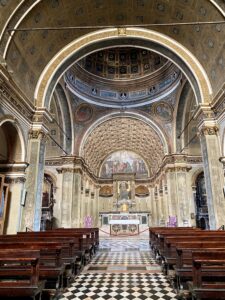 The building was constructed at the behest of Duke Gian Galeazzo Sforza, and later work continued thanks to Ludovico il Moro, who unified the sacellum into the church of Santa Maria built to contain an icon considered miraculous. The art work in question is a fresco depicting the Madonna and Child. It is said that in 1242 a vandal struck the image of the Child with a dagger, and it began to bleed.
The building was constructed at the behest of Duke Gian Galeazzo Sforza, and later work continued thanks to Ludovico il Moro, who unified the sacellum into the church of Santa Maria built to contain an icon considered miraculous. The art work in question is a fresco depicting the Madonna and Child. It is said that in 1242 a vandal struck the image of the Child with a dagger, and it began to bleed.
What characterizes the architecture of this building is a work of Bramante. In fact, he, in an attempt to recreate a larger space in small dimensions, only 97 centimeters, created an optical effect by making a false presbytery, thanks also to the apparent coffered barrel vault above the high altar. At the back of the church, however, a Roman-style bell tower dating back to the 10th century, among the oldest in Milan, was created.

